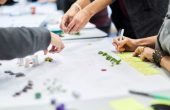
Friday 11th May: British Fashion Council: London Craft Week Panel Discussion
Last week I hosted London Craft Week panel discussion on sustainability within the fashion industry. Sustainable fashion designers, Bethany Williams and Christopher Raeburn and ‘The Sustainable Angle’ founder Nina Marenzi joined myself on the panel.
The debate on sustainability is a key pillar of the British Fashion Council’s Positive Fashion Initiative. The initiative was designed as a platform to celebrate industry best practise and encourage future business decisions to create positive change.
There are many problems we as consumers and industry need to address and it is people like Bethany, Nina and Christopher that are creating a solution to some of these challenges.
In Christopher’s first line of clothing he used one piece of material for 8 items. The material was an old army parachute which he sourced from waste. He described how his business started as a “happy accident” whilst shopping for eggs realising that if eggs can be free-range then surely he can create a similar alternative for clothes. Christopher believes that businesses like his are “not only necessary but the way forward” as the solution to creating a sustainable industry is completely design led. Bethany too added that “we need to take a 360’ degree approach – we need to use waste product – it can always be turned into something beautiful in our hands”.

“But how can we ensure the authenticity of sustainability?”
Nina Marenzi’s company ‘The Sustainable Angle’ guarantees each material they supply to their clients can be classified as sustainable. Effort and time go into the research, whether it is visiting the mills which creates the pieces or visiting the farms which source the threads. They provide materials for high street brands to high end luxury hotels – all of which want to see the physical evidence of the sustainability of the product they are purchasing. Therefore they have to set a criteria as to what classifies as sustainable e.g. the bio-diversity, the fibres, the environmental and human impact.
“In terms of being conscious about fast fashion and waste, is the consumer more aware of/getting more excited about the fact that they can now purchase sustainable clothes?”
”One would hope so” noted Christopher. Shows such as Blue Planet with a viewing audience of 60 million since airing show that people are now more aware of how humans have an effect on the planet. For example the episode which showed the sea of plastic which the oceans now house, has had a huge impact on initiatives to clean up the world’s water. Therefore “if people are changing their perspectives on how we consume, this has to have a positive impact on the fashion industry and sustainable items being purchased, people are turning to brands like ours to support this”.
Bethany’s range is at a much higher price point than the average high-street brand, thus she mentioned that for her it is hard to target a mass audience as people do not have the financial capabilities to be able to shop consistently at this expense. However “brands like mine are leading the change, working with companies like Adidas means that I can have an impact on the average shopper, even If they are not directly purchasing my clothes”.
”Can you tell me more about the Making for Change programme?”
One idea of Bethany’s designs is that she works with local communities in countries which hand craft their materials. “Working with a village in San Patrignano means each material has been ethically sourced and manufactured by hand. I then work with LCF and these materials are sent to a women’s prison facility where they will make the T-shirts which will then be sold at Lafayette Gallery in Paris – meaning that the vessels of the garment show the great work of what the 2 communities are doing”.

“Are new materials able to address the problems which currently exist?”
Nina Marenzi noted that with advancements in technology – come advancements in what they can do to materials to address the challenges which the textile industry face. “There have been several developments, fabrics such as 10 Cell have been created, where scraps are taken from production floors and are mixed with wood, so no waste is thrown away and less of a cost for manufacturers. Too, materials such as orange fibre and apple peel leather – self-explanatory made from fruit now exist as substitutions to leather”.
Christopher added that it is these materials which are the way forward, however it will take a long time to set an example and for people globally to get on board. Although when large companies e.g. Adidas created the world’s first fully recycled football kits for teams ‘Bayern Munich’ and ‘Real Madrid’, “it is these companies that are setting an example to a mass market, which will have an impact on peoples shopping habits. We have to inspire and educate, without preaching”.
“With technology changing the fashion industry, it is advancements like block chain, where we can see the alpaca from which our wool jumper is from. How is this effecting new business like yours?”
Bethany explained that technology can really help a company like hers, “it can tell a story, it helps us communicate what we are doing to the consumer”. Whilst Christopher mentioned that it can help businesses like his to get ahead of the high street retailers as they can implement it quickly on a small scale, whereas large companies cannot facilitate this. Nina too said that this is the technology which most excites people as when they can see what exactly they are buying, it has a knock on effect on their behaviour.
Questions were then asked by the audience to the panel members, from which I have picked my two favourite:
“What was your aha moment, when you realised that sustainability was really important to you and effected how you work/designed/ consumed?”
To me personally, I feel it was water. Water consumption is astronomical in the fashion industry. When countries share water; be it rivers, oceans or lakes, clean water will be more valuable than oil in the future. It will be water that that starts wars. That’s why in fashion I feel that we need to look at every aspect of the supply chain, right down to the simplest of things, the water.
“In terms of fashion, how do you practise being sustainable in your personal life?”
Bethany said that “it is easier for me, as I design and create clothes, I can make them for myself or I just shop very limited, try to buy as ethically sourced as possible”. Christopher related the story of how when he first moved to his flat in London, he bought a small wardrobe and promised himself that he would never buy more clothes than what fit into the wardrobe, so he didn’t over consumer and would try and wear these for as long as possible; “I fix clothes when they are damaged, when someone would usually throw something away – I will fix it, to make it new again”.
Video: My response to how I keep my wardrobe as sustainable as possible




